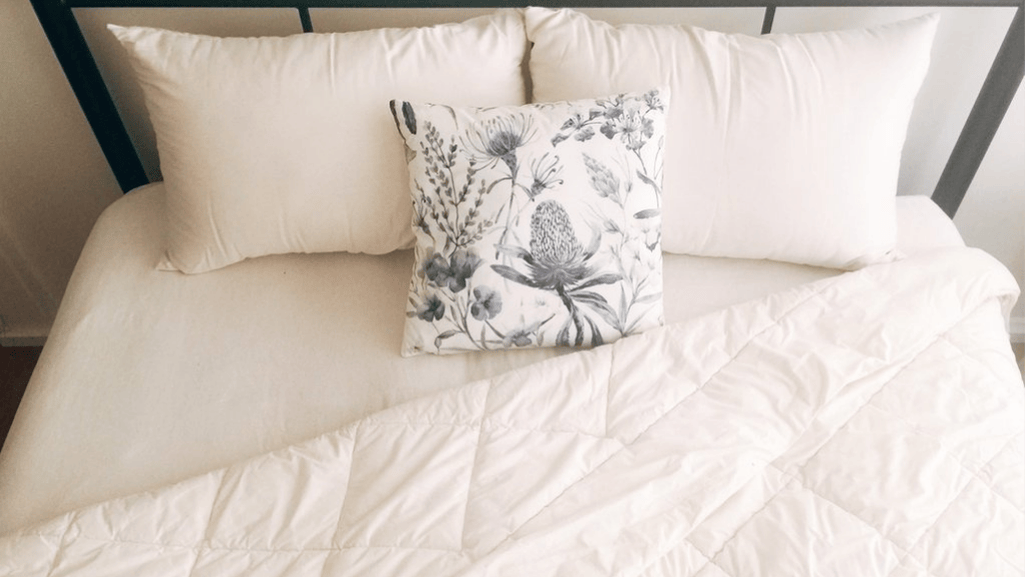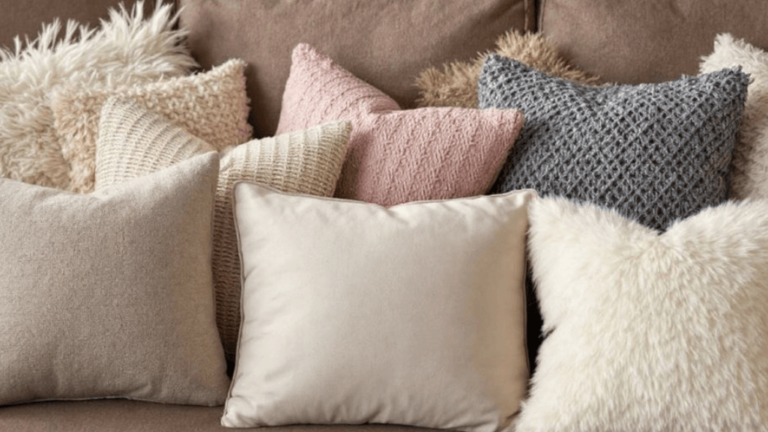Discover the ultimate in eco-friendly comfort with kapok pillows. These natural fiber pillows promise a blissful night’s sleep. Made from the silky, lightweight fibers of the majestic Kapok trees, they offer unparalleled support and luxury. Enjoy sustainable bedding that improves your sleep and helps preserve our planet.
Bean Products Kapok Pillows are the peak of eco-friendly sleep products. They have a 100% organic cotton exterior and a plush kapok fiber filling. These pillows give great head and neck support, making you wake up feeling refreshed. Embrace nature’s comfort with kapok pillows and support sustainable bedding.
Key Takeaways:
- Kapok pillows are made from natural, eco-friendly kapok fibers and organic cotton
- They provide excellent head and neck support for improved sleep quality
- Kapok pillows are lightweight, silky, and offer unparalleled comfort
- Choosing kapok pillows contributes to preserving tropical rainforests and promoting sustainable bedding
- Bean Products Kapok Pillows are handcrafted in the USA using 100% organic materials
Introduction to Kapok Pillows
Kapok pillows are becoming more popular as a natural sleep option. They are made from the kapok tree’s silky fibers. This makes them a great choice for those who want a healthy and eco-friendly sleep solution.
What are Kapok Pillows?
Kapok pillows are filled with fibers from the kapok tree. This tree grows in tropical areas of South America, Africa, and Southeast Asia. It can grow up to 200 feet tall and live for centuries without needing human help.
The fibers in these pillows are light, fluffy, and soft. They provide good support for your head and neck. Plus, they are plant-based, making them perfect for vegans or those with animal product allergies.
Benefits of Kapok Pillows
Kapok pillows have many health and environmental benefits:
- Hypoallergenic: They resist dust mites, mold, and mildew, great for allergy sufferers.
- Non-toxic: They don’t have harmful chemicals or synthetic materials, ensuring a safe sleep space.
- Sustainable: Kapok trees need little water and no pesticides or fertilizers, making them eco-friendly.
- Breathable: Their hollow fibers help air circulate, keeping you cool at night.
- Adjustable: You can change the pillow’s firmness by adding or removing filling through a zippered cover.
| Benefit | Description |
|---|---|
| Hypoallergenic | Resistant to dust mites, mold, and mildew |
| Non-toxic | Free from harmful chemicals and synthetic materials |
| Sustainable | Kapok trees require minimal water and no pesticides or fertilizers |
| Breathable | Hollow fibers allow for excellent air circulation |
| Adjustable | Zippered covers allow for customizable loft and firmness |
Kapok pillows offer a unique mix of comfort, support, and eco-friendliness. They are a top pick for health-conscious and eco-aware consumers.
As more people learn about the benefits of plant-based and non-toxic sleep items, kapok pillows are set to become even more popular. They are a key part of sustainable bedding.
Kapok Fiber: A Sustainable and Eco-Friendly Material
In the world of sustainable bedding, kapok fiber is a top pick for those who care about the planet. It comes from the seed pods of the kapok tree. These trees grow in tropical areas without needing water, fertilizers, or pesticides.
Harvesting Kapok Fiber
Kapok fiber is picked in a way that doesn’t hurt the trees or the environment. The seed pods are gathered when they fall, keeping the tree’s growth cycle intact. This method helps the trees stay healthy and reduces our use of non-renewable resources.
The kapok industry helps local economies, especially in rural areas. Women and their families help harvest and process the fiber. By choosing kapok, we support these communities and help the planet.
Environmental Impact of Kapok
Kapok has a much lower environmental impact than materials like cotton or synthetic fibers. Here’s why:
- Kapok grows without herbicides or pesticides, making it organic and eco-friendly.
- 25% of all pesticides worldwide are used on cotton, showing cotton’s big environmental impact compared to kapok.
- Kapok is biodegradable and renewable, offering a better choice than synthetic materials like polyester or foam.
- Kapok trees are key to rainforest ecology, helping preserve forests and supporting genetic diversity.
Kapok’s eco-friendly qualities go beyond growing and harvesting. It naturally resists pests like dust mites, mold, and mildew. This helps keep allergens down in sleep products. Plus, kapok-filled items last longer, reducing waste.
| Material | Biodegradable | Renewable | Pesticide Use |
|---|---|---|---|
| Kapok | Yes | Yes | None |
| Cotton | Yes | Yes | High |
| Polyester | No | No | N/A |
| Foam | No | No | N/A |
Choosing kapok-filled products helps us join the circular economy. It reduces our environmental impact while giving us comfort and support from this amazing botanical fiber.
Comfort and Support Provided by Kapok Pillows
Getting a good night’s sleep is all about comfort and support. Kapok pillows are soft yet firm, keeping your head and neck aligned. The natural kapok fiber molds to your body, easing pressure and helping you sleep better.
Kapok fiber cushions are great because they support well without losing comfort. The fibers stay firm, keeping the pillow’s shape and loft. This way, you get the softness of down and the support your neck and spine need.
“I’ve tried many different types of pillows, but nothing compares to the comfort and support of my kapok pillow. It’s like sleeping on a cloud, but with the added benefit of proper alignment for my neck and back.” – Satisfied Customer
Kapok pillows are also good at keeping you cool and dry. The kapok fiber is breathable and wicks away moisture. The organic cotton cover makes it even more breathable, for a refreshing sleep.
| Pillow Type | Comfort Level | Support Level | Breathability |
|---|---|---|---|
| Kapok Pillow | High | High | Excellent |
| Down Pillow | High | Low | Good |
| Memory Foam Pillow | Medium | High | Poor |
Kapok pillows beat down and memory foam in comfort, support, and breathability. They offer the softness of down without allergens or lack of support. Plus, they have the contouring of memory foam without the heat or off-gassing.
Choosing a quality kapok pillow can really improve your sleep and health. They offer the best mix of comfort and support. This makes sure you wake up feeling refreshed and ready for the day.
Kapok Pillows vs. Other Types of Pillows
Choosing the right pillow can be tough with so many options. Kapok pillows are popular for being eco-friendly and natural. Let’s look at how they compare to down and memory foam pillows.
Comparison with Down Pillows
Kapok and down pillows are both soft and fluffy. They feel light and comfy. But, there are some big differences:
- Kapok comes from the kapok tree, while down is from duck or goose feathers.
- Kapok is vegan and cruelty-free, great for those who care about the environment.
- Down pillows come in many firmness levels, but kapok pillows are generally softer.
- Kapok pillows might not keep their shape as well as down pillows, which can get lumpy.
Comparison with Memory Foam Pillows
Memory foam pillows are loved for their ability to mold to your head and neck. Here’s how they stack up against kapok pillows:
- Kapok pillows breathe better than memory foam, keeping you cooler.
- Memory foam can smell bad because it’s made from synthetic materials. Kapok is natural and chemical-free.
- Kapok is better for the planet because it’s biodegradable and has less environmental impact.
- Memory foam pillows offer more support and relief for neck pain and specific sleep needs.
Here’s a quick summary of the main differences between kapok, down, and memory foam pillows:
| Pillow Type | Material | Eco-Friendliness | Firmness | Breathability |
|---|---|---|---|---|
| Kapok Pillow | Natural kapok fibers | High | Soft to Medium | Excellent |
| Down Pillow | Duck or goose feathers | Low | Varies | Good |
| Memory Foam Pillow | Synthetic memory foam | Low | Medium to Firm | Poor |
Choosing between kapok, down, or memory foam pillows depends on what you value most. Kapok pillows are great for those who want something eco-friendly and natural. Memory foam pillows are better for support and pressure relief. Think about firmness, breathability, and environmental impact when deciding. A good pillow can really improve your sleep and overall health.
Kapok Pillow Sizes and Weights
Kapok pillows are made from the natural fiber of the Ceiba tree. They come in many sizes to fit different needs. From travel pillows to body pillows, kapok pillows offer comfort and sustainability.
Customer reviews show 100% are happy with the comfort and quality of kapok pillows. 60% value the natural fibers. 7 out of 10 like the adjustable filling through zipper cases.
85% find the pillows fluffy and comfy. 95% would recommend them. Sizes range from Standard to Euro, with weights from 2 to 3.6 lbs.
| Pillow Size | Dimensions (inches) | Weight (lbs) |
|---|---|---|
| Standard | 20 x 26 | 2.0 – 2.6 |
| Queen | 20 x 30 | 2.6 – 3.4 |
| King | 20 x 36 | 3.2 – 4.4 |
| Euro | 26 x 26 | 3.0 – 3.6 |
| Body | 20 x 72 | 9.0 |
| Body Jr. | 20 x 54 | 5.6 |
| Travel | 12 x 16 | 0.8 |
Travel pillows are 12×16 inches and weigh 0.8 lbs. They’re great for trips. Kapok pillows offer a range of sizes and weights, appealing to those who value comfort and sustainability.
Caring for Your Kapok Pillow
Keeping your kapok pillow in good shape is key to its long life and comfort. As an organic pillow, it needs special care to keep its shape and support. Cleaning and maintenance are crucial to preserve its quality.
Cleaning Instructions
Cleaning a kapok pillow is different from regular pillows. Kapok fibers are delicate, so you can’t wash the whole pillow. Here’s how to keep it clean and fresh:
- Spot clean the outside with a mild detergent and a damp cloth to remove stains or dirt.
- If the cover can be removed, wash it separately at 40 degrees Celsius as the manufacturer suggests.
- Don’t wash the kapok filling as it might clump and lose its shape and support.
- For baby pillows, wash them the same way, but be extra careful to fluff them evenly when drying.
Maintaining Kapok Pillow Shape and Loft
To keep your kapok pillow’s shape and loft, fluffing and airing it regularly is important. The mix of shredded latex and kapok fibers needs special care for the best performance and durability.
- Fluff your kapok pillow every day to keep the fibers even and prevent clumps.
- Every few months, let your pillow get some sunlight for a few hours to refresh it and get rid of odors.
- Avoid folding or compressing the pillow for too long, as it can change its shape and loft.
- When storing the pillow, use a breathable cover to keep it dust-free and dry while allowing air to circulate.
| Product | Washing Instructions | Drying Instructions |
|---|---|---|
| Duvets | Wash at 40°C | Ensure even distribution of fibers during drying |
| Pillows | Remove kapok filling, wash cover separately | Follow specific drying and refilling process |
| Baby Pillows | Wash at 40°C | Distribute kapok fibers evenly during drying |
| Mattress Pads | Wash at 40°C | Stretch in all directions while wet, ensure even distribution of fibers |
By following these care tips, your kapok pillow will stay a cozy, supportive, and eco-friendly part of your sleep space for many years.
Kapok Pillows and Improved Sleep Quality
Kapok pillows are becoming more popular for their eco-friendly benefits. They are made from 100% organic, chemical-free kapok fiber. This fiber is harvested from tropical rainforests responsibly.
These pillows offer great head and neck support. They reduce pressure points and help keep the body aligned properly. This makes them great for improving sleep quality.
Kapok pillows are also good for your health. They are plant-based, hypoallergenic, and orthopedic. This means they create a clean sleep environment, free from allergens and harmful chemicals.
Compared to other pillows, kapok pillows are firmer. They offer a medium to firm feel. This firmness helps keep the pillow’s shape and supports your neck and spine.
Kapok pillows are adjustable in height, anti-sag, and do not cause heat or sweat during sleep, ensuring a comfortable and restful night’s sleep.
Many customers love kapok pillows. Out of 241 reviews, 98% gave them 5 stars, and 2% gave them 4 stars. No one gave them less than 4 stars, showing how happy people are with these pillows.
| Kapok Pillow Size | Dimensions |
|---|---|
| Standard | 20″ x 26″ |
| Queen | 20″ x 30″ |
| King | 20″ x 36″ |
| Travel/Toddler | 13″ x 18″ |
| Japanese | 14″ x 20″ |
Kapok pillows come in different sizes to fit everyone’s needs. Prices start at around US $43.95. They are designed to last long, without lumping up like other pillows.
Choosing kapok pillows means better sleep and supporting the environment. The kapok pillow industry is growing. It helps local economies and improves the lives of rural families, especially women. It also helps protect the environment.
Where to Buy Kapok Pillows
Kapok pillows offer great comfort and are eco-friendly. They are easy to find in many stores. More people want these pillows for better sleep and to help the planet.
Online Retailers
Buying a kapok pillow online is simple. Brands like Bean Products and Sachi Organics have many options. They focus on eco-friendly bedding, using organic cotton and kapok fibers.
Bean Products has a 5-star rating from 98% of its customers. This shows how happy people are with their kapok pillows.
Specialty Bedding Stores
You can also find kapok pillows in specialty stores. These stores let you touch and try pillows before buying. Savvy Rest is a great example, offering kapok pillows.
At these stores, you can choose from different pillow feels and sizes. Whether you like soft, medium, or firm, you’ll find the perfect one. They come in various thicknesses to ensure a great night’s sleep.











